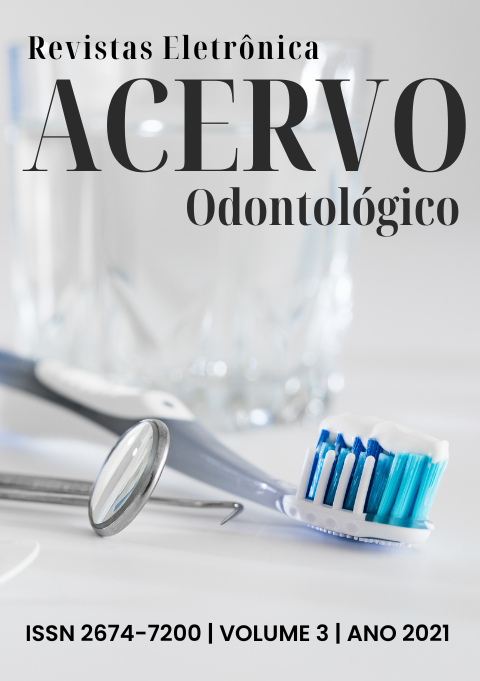O papel do 10-MDP no processo da adesão
##plugins.themes.bootstrap3.article.main##
Resumo
Esse artigo buscou analisar a atuação dos monômeros funcionais no processo da adesão. A introdução destes nos sistemas adesivos permitiu intensificar as forças adesivas através de ligações químicas e, dessa forma, aumentar a qualidade da odontologia restauradora. O 10-metacriloiloxidecil di-hidrogênio fosfato (10-MDP) é um monômero que possui a capacidade de melhorar a adesão quando comparado aos outros monômeros funcionais. Dessa forma, o objetivo deste artigo é apresentar, por meio de uma revisão de literatura, o papel do monômero 10-MDP no processo de adesão em restaurações dentárias. Foi realizado um levantamento bibliográfico nas bases de dados Medline, BVS e Lilacs utilizando como termos de busca: Falha de Restauração Dentária; Cimentos Dentários; Odontologia; Adesivos. A literatura enfatiza que o 10-MDP é um monômero que se destaca por apresentar ligação tanto a hidroxiapatita dos tecidos dentais quanto aos compósitos e cimentos resinosos promovendo, assim, uma união mais estável e duradoura. Além disso, também atua como agente ligante entre compósitos resinosos e óxidos metálicos, melhorando a resistência de união à zircônia, por exemplo, através de uma interação química entre sua superfície e o cimento resinoso aplicado. Sendo assim, o 10-MDP é considerado como padrão ouro para adesão em dentina.
##plugins.themes.bootstrap3.article.details##
Copyright © | Todos os direitos reservados.
A revista detém os direitos autorais exclusivos de publicação deste artigo nos termos da lei 9610/98.
Reprodução parcial
É livre o uso de partes do texto, figuras e questionário do artigo, sendo obrigatória a citação dos autores e revista.
Reprodução total
É expressamente proibida, devendo ser autorizada pela revista.
Referências
2. ARINELLI AMD, et al. Sistemas adesivos atuais. Rev Bras Odontol. 2016; 73(3): 242.
3. BRESCHI L, et al. Use of a specific MMP-inhibitor (galardin) for preservation of hybrid layer. Dent Mater. 2010; 26(6):571-578.
4. CARDOSO MV, et al. Current aspects on bonding effectiveness and stability in adhesive dentistry. Aust. Dent. 2011; 56:31-44.
5. CARRILHO E, et al. 10-MDP Based Dental Adhesives: Adhesive Interface Characterization and Adhesive Stability - A Systematic Review. Materials (Basel). 2019; 12 (5):790
6. CARVALHO EC, et al. Análise de interfaces de sistemas restauradores diretos em esmalte e em dentina humana. Matéria (Rio J.). 2019; 24(3): e12391.
7. DE MELO LA, et al. Efficacy of prostheses bonding using silane incorporated to universal adhesives or applied separately: A systematic review. J Indian Prosthodont Soc. 2019; 19(1): 3.
8. FEITOSA VP, et al. The role of spacer carbon chain in acidic functional monomers on the physicochemical properties of self-etch dental adhesives. J Dent. 2014; 42(5): 565-574.
9. FUJITA-NAKAJIMA K, et al. NMR study on the demineralization mechanism of the enamel and dentin surfaces in MDP-based all-in-one adhesive. Dent. Mater. J. 2018; 37 (4): 693-701.
10. HOSHIKA S, et al. GPDM- and 10-MDP-based Self-etch Adhesives Bonded to Bur-cut and Uncut Enamel – “Immediate” and “Aged” μTBS. J Adhes Dent. 2018; 20(2): 113–120.
11. KIM EC, et al. Effect of the Acidic Dental Resin Monomer 10‐methacryloyloxydecyl Dihydrogen Phosphate on Odontoblastic Differentiation of Human Dental Pulp Cells. Basic Clin Pharmacol Toxicol. 2015; 117(5): 340-349.
12. LLERENA-ICOCHEA AE, et al. Bonding Polycrystalline Zirconia With 10-MDP–containing Adhesives. Oper. Dent. 2017; 42(3): 335-341.
13. MEERBEEK BV, et al. From Buonocore’s Pioneering Acid-Etch Technique to Self-Adhering Restoratives. A Status Perspective of Rapidly Advancing Dental Adhesive Technology. J Adhes Dent. 2020; 22 (1): 7-34.
14. NAKABAYASHI N, et al. The promotion of adhesion by the infiltration of monomers into tooth substrates. Journal of biomedical materials research. 1982; 16(3): 265-273.
15. PUTZEYS E, et al. In-vitro transdentinal diffusion of monomers from adhesives. J Dent. 2018; 75:91-97.
16. RUSSO DS, et al. Adhesion to Zirconia: A Systematic Review of Current Conditioning Methods and Bonding Materials. Dent J. 2019; 7(3): 74.
17. TERUEL JD, et al. Comparison of Chemical Composition of Enamel and Dentine in Human, Bovine, Porcine and Ovine Teeth. Arch Oral Biol. 2015; 60(5): 768-75.
18. TJÄDERHANE L, et al. Optimizing dentin bond durability: control of collagen degradation by matrix metalloproteinases and cysteine cathepsins. Dent Mater. 2013; 29(1):116-135.
19. TURP V, et al. Adhesion of 10-MDP containing resin cements to dentin with and without the etch-and-rinse technique. J Adv Prosthodont. 2013; 5(3): 226-233.
20. WANG X, et al. Influence of priming time and primer’s concentrations on bovine enamel bond strengths. J Adhes Sci Technol. 2013; 27(23): 2558-2570.
21. YAGUCHI T. Layering mechanism of MDP-Ca salt produced in demineralization of enamel and dentin apatite. Dent Mater. 2017; 33 (1): 23-32.
22. YOSHIHARA K, et al. Functional monomer impurity affects adhesive performance. Dent Mater. 2015; 31 (12): 1493-501.
23. ZARANDI PK, et al. The Effect of Sandblasting and Coating of Zirconia by Nano Composites on Bond Strength of Zirconia to Resin Cements. J Dent. (Shiraz) 2020; 21(1): 63–68.

